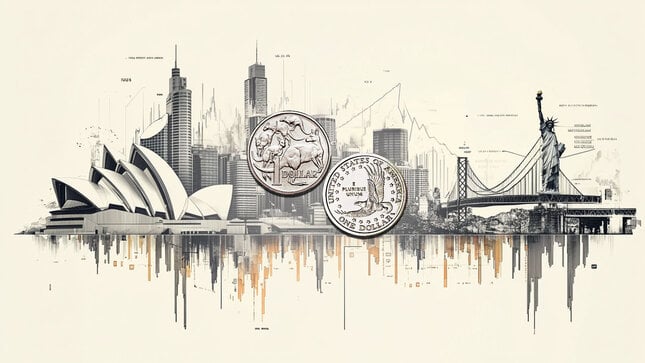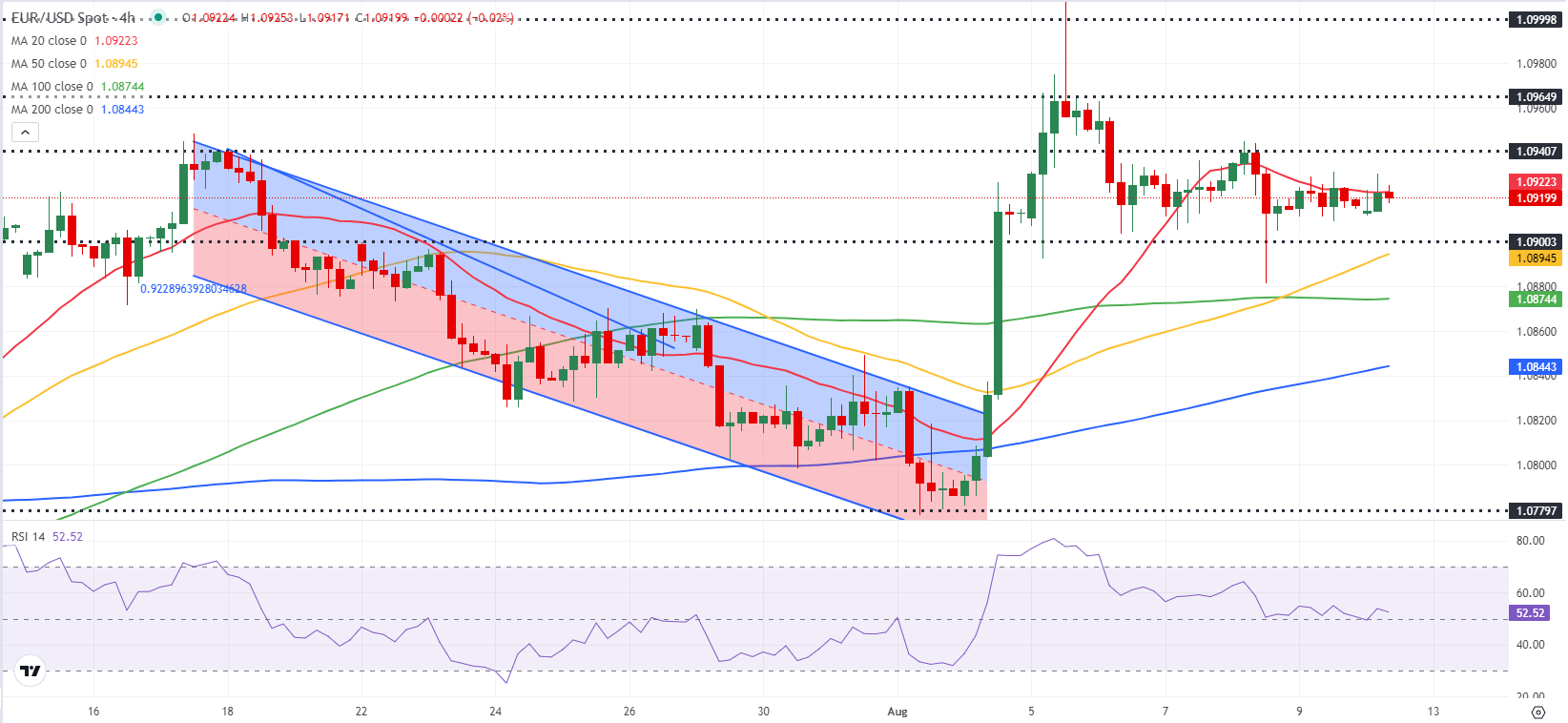- EUR/USD extends sideways grind above 1.0900 to start the new week.
- Investors keep a close eye on headlines surrounding Iran-Israel conflict.
- The economic calendar will not feature any high-tier data releases on Monday.
EUR/USD continues to move up and down in a narrow range above 1.0900 after closing the previous week virtually unchanged. The pair's technical outlook does not offer any directional clues as investors remain on the sidelines while keeping a close eye on geopolitical headlines.
Euro PRICE Last 7 days
The table below shows the percentage change of Euro (EUR) against listed major currencies last 7 days. Euro was the weakest against the New Zealand Dollar.
| USD | EUR | GBP | JPY | CAD | AUD | NZD | CHF | |
|---|---|---|---|---|---|---|---|---|
| USD | -0.06% | 0.31% | 0.50% | -1.07% | -1.27% | -1.17% | 1.23% | |
| EUR | 0.06% | 0.29% | 0.40% | -1.13% | -1.20% | -1.22% | 1.19% | |
| GBP | -0.31% | -0.29% | 0.17% | -1.40% | -1.48% | -1.50% | 0.89% | |
| JPY | -0.50% | -0.40% | -0.17% | -1.52% | -1.80% | -1.64% | 0.77% | |
| CAD | 1.07% | 1.13% | 1.40% | 1.52% | -0.17% | -0.10% | 2.14% | |
| AUD | 1.27% | 1.20% | 1.48% | 1.80% | 0.17% | -0.02% | 2.41% | |
| NZD | 1.17% | 1.22% | 1.50% | 1.64% | 0.10% | 0.02% | 2.43% | |
| CHF | -1.23% | -1.19% | -0.89% | -0.77% | -2.14% | -2.41% | -2.43% |
The heat map shows percentage changes of major currencies against each other. The base currency is picked from the left column, while the quote currency is picked from the top row. For example, if you pick the Euro from the left column and move along the horizontal line to the US Dollar, the percentage change displayed in the box will represent EUR (base)/USD (quote).
Markets turn cautious at the beginning of the week on growing fears over the Iran-Israel conflict turning into a deepening crisis in the Middle East. Although Euro Stoxx 50 Index is modestly higher in the first trading session of the week, US stock index futures struggle to gain traction.
The economic calendar will not offer any high-impact macroeconomic data releases on Monday. On Wednesday, the US Bureau of Labor Statistics will publish the Consumer Price Index (CPI) data for July.
In case geopolitical tensions escalate further in the second half of the day, major equity indexes in the US could turn south. In this scenario, the US Dollar (USD) could hold its ground against its major rivals and make it difficult for EUR/USD to gain traction. On the other hand, the pair could stretch higher if risk flows return to markets following Wall Street's opening bell.
EUR/USD Technical Analysis
The Relative Strength Index (RSI) indicator on the 4-hour chart continues to move sideways near 50, reflecting EUR/USD's indecisiveness.
First support could be seen at 1.0900 (psychological level, static level) ahead of 1.0880-1.0870, where the 100-period and the 20-day Simple Moving Averages (SMA) are located, and 1.0845 (200-period SMA).
In case the pair breaks above 1.0940 (static level), it could encounter next resistance levels at 1.0960 (static level) and 1.1000 (psychological level, static level).
Euro FAQs
The Euro is the currency for the 20 European Union countries that belong to the Eurozone. It is the second most heavily traded currency in the world behind the US Dollar. In 2022, it accounted for 31% of all foreign exchange transactions, with an average daily turnover of over $2.2 trillion a day. EUR/USD is the most heavily traded currency pair in the world, accounting for an estimated 30% off all transactions, followed by EUR/JPY (4%), EUR/GBP (3%) and EUR/AUD (2%).
The European Central Bank (ECB) in Frankfurt, Germany, is the reserve bank for the Eurozone. The ECB sets interest rates and manages monetary policy. The ECB’s primary mandate is to maintain price stability, which means either controlling inflation or stimulating growth. Its primary tool is the raising or lowering of interest rates. Relatively high interest rates – or the expectation of higher rates – will usually benefit the Euro and vice versa. The ECB Governing Council makes monetary policy decisions at meetings held eight times a year. Decisions are made by heads of the Eurozone national banks and six permanent members, including the President of the ECB, Christine Lagarde.
Eurozone inflation data, measured by the Harmonized Index of Consumer Prices (HICP), is an important econometric for the Euro. If inflation rises more than expected, especially if above the ECB’s 2% target, it obliges the ECB to raise interest rates to bring it back under control. Relatively high interest rates compared to its counterparts will usually benefit the Euro, as it makes the region more attractive as a place for global investors to park their money.
Data releases gauge the health of the economy and can impact on the Euro. Indicators such as GDP, Manufacturing and Services PMIs, employment, and consumer sentiment surveys can all influence the direction of the single currency. A strong economy is good for the Euro. Not only does it attract more foreign investment but it may encourage the ECB to put up interest rates, which will directly strengthen the Euro. Otherwise, if economic data is weak, the Euro is likely to fall. Economic data for the four largest economies in the euro area (Germany, France, Italy and Spain) are especially significant, as they account for 75% of the Eurozone’s economy.
Another significant data release for the Euro is the Trade Balance. This indicator measures the difference between what a country earns from its exports and what it spends on imports over a given period. If a country produces highly sought after exports then its currency will gain in value purely from the extra demand created from foreign buyers seeking to purchase these goods. Therefore, a positive net Trade Balance strengthens a currency and vice versa for a negative balance.
Information on these pages contains forward-looking statements that involve risks and uncertainties. Markets and instruments profiled on this page are for informational purposes only and should not in any way come across as a recommendation to buy or sell in these assets. You should do your own thorough research before making any investment decisions. FXStreet does not in any way guarantee that this information is free from mistakes, errors, or material misstatements. It also does not guarantee that this information is of a timely nature. Investing in Open Markets involves a great deal of risk, including the loss of all or a portion of your investment, as well as emotional distress. All risks, losses and costs associated with investing, including total loss of principal, are your responsibility. The views and opinions expressed in this article are those of the authors and do not necessarily reflect the official policy or position of FXStreet nor its advertisers. The author will not be held responsible for information that is found at the end of links posted on this page.
If not otherwise explicitly mentioned in the body of the article, at the time of writing, the author has no position in any stock mentioned in this article and no business relationship with any company mentioned. The author has not received compensation for writing this article, other than from FXStreet.
FXStreet and the author do not provide personalized recommendations. The author makes no representations as to the accuracy, completeness, or suitability of this information. FXStreet and the author will not be liable for any errors, omissions or any losses, injuries or damages arising from this information and its display or use. Errors and omissions excepted.
The author and FXStreet are not registered investment advisors and nothing in this article is intended to be investment advice.
Recommended Content
Editors’ Picks

AUD/USD stays firm near 0.6300 amid modest risk appetite
AUD/USD is posting small gains near 0.6300 in early Asian trades on Monday, opening the week on the front foot. Risk sentiment remains in a sweeter spot following the weekend's news of lower US tariffs on Chinese electronic supply chain. Tariffs talks will remain on the radar.

USD/JPY recovers to 143.00 amid volatile trading
USD/JPY is trimming losses to retake 143\.00 in Monday's Asian trading. The US Dollar pauses its latest leg down, with traders digesting Trump's tariff news from the weekend. However, the Fed-BoJ policy divergence expectations underpin the Japanese Yen, keeping the weight intact on the pair.

Gold retreats from record highs of $3,245 as US Dollar finds its feet
Gold is rereating from record highs of $3,245 early Monday, extending Friday's late pullback. Reducded demand for safe-havens and a broad US Dollar rebound undermine the yellow metal amid the news of not-so-steep US tariffs on China's semiconductors and electronics.

Week ahead: ECB set to cut, BoC might pause as Trump U-turns on tariffs
ECB is expected to trim rates, but the BoC might pause this time. CPI data also in the spotlight; due in UK, Canada, New Zealand and Japan. Retail sales the main release in the United States. China GDP eyed as Beijing not spared by Trump.

Is a recession looming?
Wall Street skyrockets after Trump announces tariff delay. But gains remain limited as Trade War with China continues. Recession odds have eased, but investors remain fearful. The worst may not be over, deeper market wounds still possible.

The Best brokers to trade EUR/USD
SPONSORED Discover the top brokers for trading EUR/USD in 2025. Our list features brokers with competitive spreads, fast execution, and powerful platforms. Whether you're a beginner or an expert, find the right partner to navigate the dynamic Forex market.
